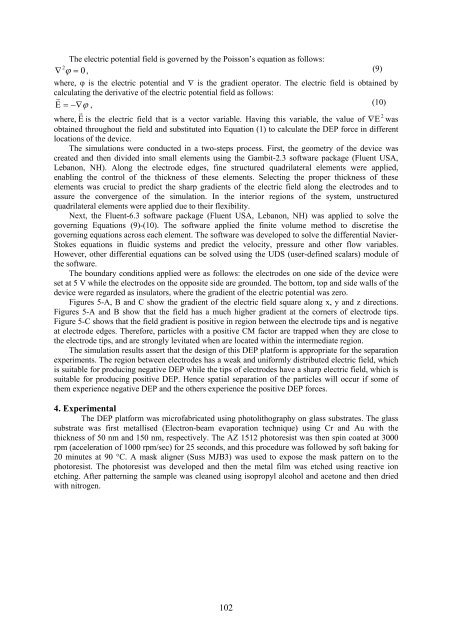Workshop proceeding - final.pdf - Faculty of Information and ...
Workshop proceeding - final.pdf - Faculty of Information and ...
Workshop proceeding - final.pdf - Faculty of Information and ...
Create successful ePaper yourself
Turn your PDF publications into a flip-book with our unique Google optimized e-Paper software.
The electric potential field is governed by the Poisson’s equation as follows:<br />
2<br />
∇ ϕ = 0 ,<br />
(9)<br />
where, φ is the electric potential <strong>and</strong> ∇ is the gradient operator. The electric field is obtained by<br />
calculating the derivative <strong>of</strong> the electric potential field as follows:<br />
E r = −∇ϕ , (10)<br />
where, E r 2<br />
is the electric field that is a vector variable. Having this variable, the value <strong>of</strong> ∇E was<br />
obtained throughout the field <strong>and</strong> substituted into Equation (1) to calculate the DEP force in different<br />
locations <strong>of</strong> the device.<br />
The simulations were conducted in a two-steps process. First, the geometry <strong>of</strong> the device was<br />
created <strong>and</strong> then divided into small elements using the Gambit-2.3 s<strong>of</strong>tware package (Fluent USA,<br />
Lebanon, NH). Along the electrode edges, fine structured quadrilateral elements were applied,<br />
enabling the control <strong>of</strong> the thickness <strong>of</strong> these elements. Selecting the proper thickness <strong>of</strong> these<br />
elements was crucial to predict the sharp gradients <strong>of</strong> the electric field along the electrodes <strong>and</strong> to<br />
assure the convergence <strong>of</strong> the simulation. In the interior regions <strong>of</strong> the system, unstructured<br />
quadrilateral elements were applied due to their flexibility.<br />
Next, the Fluent-6.3 s<strong>of</strong>tware package (Fluent USA, Lebanon, NH) was applied to solve the<br />
governing Equations (9)-(10). The s<strong>of</strong>tware applied the finite volume method to discretise the<br />
governing equations across each element. The s<strong>of</strong>tware was developed to solve the differential Navier-<br />
Stokes equations in fluidic systems <strong>and</strong> predict the velocity, pressure <strong>and</strong> other flow variables.<br />
However, other differential equations can be solved using the UDS (user-defined scalars) module <strong>of</strong><br />
the s<strong>of</strong>tware.<br />
The boundary conditions applied were as follows: the electrodes on one side <strong>of</strong> the device were<br />
set at 5 V while the electrodes on the opposite side are grounded. The bottom, top <strong>and</strong> side walls <strong>of</strong> the<br />
device were regarded as insulators, where the gradient <strong>of</strong> the electric potential was zero.<br />
Figures 5-A, B <strong>and</strong> C show the gradient <strong>of</strong> the electric field square along x, y <strong>and</strong> z directions.<br />
Figures 5-A <strong>and</strong> B show that the field has a much higher gradient at the corners <strong>of</strong> electrode tips.<br />
Figure 5-C shows that the field gradient is positive in region between the electrode tips <strong>and</strong> is negative<br />
at electrode edges. Therefore, particles with a positive CM factor are trapped when they are close to<br />
the electrode tips, <strong>and</strong> are strongly levitated when are located within the intermediate region.<br />
The simulation results assert that the design <strong>of</strong> this DEP platform is appropriate for the separation<br />
experiments. The region between electrodes has a weak <strong>and</strong> uniformly distributed electric field, which<br />
is suitable for producing negative DEP while the tips <strong>of</strong> electrodes have a sharp electric field, which is<br />
suitable for producing positive DEP. Hence spatial separation <strong>of</strong> the particles will occur if some <strong>of</strong><br />
them experience negative DEP <strong>and</strong> the others experience the positive DEP forces.<br />
4. Experimental<br />
The DEP platform was micr<strong>of</strong>abricated using photolithography on glass substrates. The glass<br />
substrate was first metallised (Electron-beam evaporation technique) using Cr <strong>and</strong> Au with the<br />
thickness <strong>of</strong> 50 nm <strong>and</strong> 150 nm, respectively. The AZ 1512 photoresist was then spin coated at 3000<br />
rpm (acceleration <strong>of</strong> 1000 rpm/sec) for 25 seconds, <strong>and</strong> this procedure was followed by s<strong>of</strong>t baking for<br />
20 minutes at 90 °C. A mask aligner (Suss MJB3) was used to expose the mask pattern on to the<br />
photoresist. The photoresist was developed <strong>and</strong> then the metal film was etched using reactive ion<br />
etching. After patterning the sample was cleaned using isopropyl alcohol <strong>and</strong> acetone <strong>and</strong> then dried<br />
with nitrogen.<br />
102
















